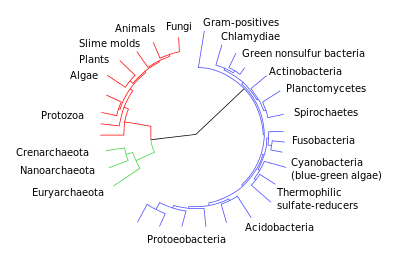Quantum evolution
- For the alternative non-standard theory, see Quantum evolution (alternative).
| Part of a series on |
| Evolutionary biology |
|---|
 |
|
History of evolutionary theory |
|
Fields and applications
|
|
Quantum evolution is a component of George Gaylord Simpson's multi-tempoed theory of evolutionary change proposed to explain the rapid emergence of higher taxonomic groups in the fossil record. According to Simpson, evolutionary rates differ from group to group and even among closely related lineages. These different rates of evolutionary change were designated by Simpson as horotelic (medium tempo), bradytelic (slow tempo), and tachytelic (rapid tempo).
Quantum evolution differed from these styles of change in that it involved a drastic shift in the adaptive zones of certain classes of animals. The word "quantum" therefore refers to an "all-or-none reaction", where transitional forms are particularly unstable, and perished rapidly and completely.[1] Although quantum evolution may happen at any taxonomic level,[2] it plays a much larger role in "the origin taxonomic units of relatively high rank, such as families, orders, and classes."[3]
Mechanisms
According to Simpson (1944), quantum evolution relied heavily upon Sewall Wright's theory of random genetic drift. Simpson believed that major evolutionary transitions would arise when small populations—isolated and limited from gene flow—would fixate upon unusual gene combinations. This "inadaptive phase" (by genetic drift) would then (by natural selection) drive a deme population from one stable adaptive peak to another on the adaptive fitness landscape. However, in his Major Features of Evolution (1953) Simpson wrote that it was still controversial:
"whether prospective adaptation as prelude to quantum evolution arises adaptively or inadaptively. It was concluded above that it usually arises adaptively . . . . The precise role of, say, genetic drift in this process thus is largely speculative at present. It may have an essential part or none. It surely is not involved in all cases of quantum evolution, but there is a strong possibility that it is often involved. If or when it is involved, it is an initiating mechanism. Drift can only rarely, and only for lower categories, have completed the transition to a new adaptive zone."[4]
This preference for adaptive over inadaptive forces led Stephen Jay Gould to call attention to the "hardening of the Modern Synthesis", a trend in the 1950s where adaptationism took precedence over the pluralism of mechanisms common in the 1930s and 40s.[5]
Simpson considered quantum evolution his crowning achievement, being "perhaps the most important outcome of [my] investigation, but also the most controversial and hypothetical."[3]
See also
References
- ↑ Gould, S. J. (1980). "G. G. Simpson, Paleontology and the Modern Synthesis." In E. Mayr and W. B. Provine, eds., The Evolutionary Synthesis. Cambridge MA: Harvard University Press, pp. 153–172.
- ↑ Simpson, G. G. (1953). The Major Features of Evolution. New York: Columbia Univ. Press, p. 389.
- 1 2 Simpson, G. G. (1944). Tempo and Mode in Evolution. New York: Columbia Univ. Press, p. 206.
- ↑ Simpson, G. G. (1953). The Major Features of Evolution, p. 390.
- ↑ Gould, S. J. (1983). "The hardening of the Modern Synthesis" In Marjorie Grene, ed., Dimensions of Darwinism. Cambridge UK: Cambridge University Press, pp. 71-93.
Sources
- Eldredge, Niles (1995). Reinventing Darwin. New York: John Wiley & Sons. pp. 20-26.
- Gould, S. J. (1994). "Tempo and mode in the macroevolutionary reconstruction on Darwinism" PNAS USA 91(15): 6764-71.
- Gould S.J. (2002). The Structure of Evolutionary Theory Cambridge MA: Harvard Univ. Press. pp. 529-31.
- Mayr, Ernst (1976). Evolution and the Diversity of Life. Cambridge MA: Belknap Press. p. 206.
- Mayr, Ernst (1982). The Growth of Biological Thought. Cambridge MA: Belknap Press. pp. 555, 609-10.
External links
- George Gaylord Simpson - Biographical sketch.
- Tempo and Mode in Evolution: Genetics and Paleontology 50 Years After Simpson